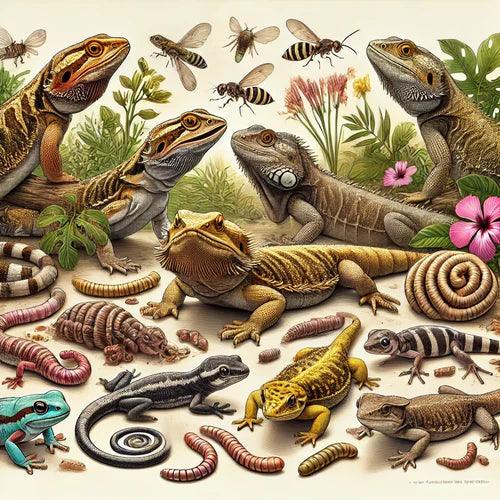
Reptile Feeding Schedule Guide: How Often and How Much to Feed
Matt GorenShare
Feeding your reptiles the right amount at the right time can make the difference between a thriving pet and one that struggles with weight, energy, or health issues. Whether you’re raising a bearded dragon, leopard gecko, or chameleon, understanding how often and how much to feed ensures their nutrition mimics the rhythms of their natural diet.
This guide provides a detailed feeding chart and schedules tailored to specific reptiles so you never have to second-guess again.
Why Feeding Schedules Matter
Reptiles have unique metabolisms that require carefully timed meals. Too much food can cause obesity, while too little can stunt growth and cause weakness. A proper feeding schedule:
- Supports steady, healthy growth (especially for juveniles).
- Prevents obesity, lethargy, and other diet-related health issues.
- Mimics wild feeding behaviors, reducing stress and encouraging natural instincts.
Quick Tip: Always adjust feeding schedules based on your reptile’s age, size, and activity levels.
Bearded Dragon Feeding Schedule
Bearded dragons are omnivores, requiring both insects and greens. Juveniles need more protein, while adults transition to a more plant-based diet.
| Age | Insects | Greens/Vegetables | Frequency |
|---|---|---|---|
| 0–6 months | Small insects (superworms, roaches) | Daily | 2–3 times per day |
| 6–12 months | Larger insects, fewer insects | Daily | 1–2 times per day |
| 1+ years (Adults) | Insects 2–3 times per week | Daily (80% of diet) | Greens every day, insects 2x/wk |
Portion: Allow juveniles to eat as many insects as they can in 10–15 minutes. For adults, limit insects and focus on greens.
Pro Tip: Include hydrating feeders like hornworms in their diet to prevent dehydration.
Leopard Gecko Feeding Schedule
Leopard geckos are insectivores that thrive on high-protein, small feeders. Smaller insects are easier for them to digest and more closely mimic the prey they would hunt in the wild, such as small beetles or crickets. Additionally, the size and movement of smaller feeders encourage natural hunting behaviors, keeping them active and engaged during feeding.
| Age | Feeder Insects | Frequency |
|---|---|---|
| 0–6 months | Small mealworms, crickets | Daily |
| 6–12 months | Mealworms, roaches, crickets | Every other day |
| 1+ years (Adults) | Larger mealworms, superworms | 2–3 times per week |
Portion: Offer 2–3 appropriately-sized insects per inch of body length per feeding.
Pro Tip: Dust feeders with calcium powder for juveniles to support strong bones and growth.
Chameleon Feeding Schedule
Chameleons require careful feeding schedules with moisture-rich insects to stay hydrated.
| Age | Feeder Insects | Frequency |
|---|---|---|
| 0–6 months | Small hornworms, crickets | Twice per day |
| 6–12 months | Hornworms, discoid roaches | Once per day |
| 1+ years (Adults) | Hornworms, crickets, treats | Every other day |
Portion: Feed 4–6 insects per feeding, appropriately sized for the chameleon’s head.
Pro Tip: Chameleons hydrate from food and misting—add moisture-rich feeders like hornworms to their diet.
Crested Gecko Feeding Schedule
Crested geckos primarily eat fruit and nectar-based diets, with occasional insect supplements.
| Age | Diet | Frequency |
|---|---|---|
| 0–6 months | Fruit diet + tiny insects | Daily |
| 6–12 months | Fruit diet + small roaches | 3–4 times per week |
| 1+ years (Adults) | Commercial fruit diet only | 3 times per week, insects 1x/wk |
Pro Tip: Use dusted discoid roaches or superworms as occasional protein treats.
Ball Python Feeding Schedule
Ball pythons eat far less frequently than other reptiles due to their slow metabolisms.
| Age | Prey Size | Frequency |
|---|---|---|
| Hatchlings | Small mice | Every 5–7 days |
| Juveniles | Larger mice | Every 7–10 days |
| Adults | Adult rats or large prey | Every 10–14 days |
Quick Tip: Ensure prey is no larger than the widest part of your snake’s body to prevent regurgitation.
General Feeding Guidelines
Portion Sizes:
- Prey should be no larger than the reptile’s head or the widest part of its body.
- Time-based feeding (like bearded dragons): Feed as much as they can eat in 10–15 minutes.
Signs of Overfeeding:
- Weight gain and lethargy.
- Regurgitation after meals.
Signs of Underfeeding:
- Weight loss and visible ribs or tail bones.
- Reduced activity and lack of hunting interest.
FAQs
How do I know if my reptile is eating enough?
Monitor weight regularly and look for signs of healthy growth, activity, and body condition. Juveniles should grow steadily, while adults should maintain a consistent weight.
What if my reptile refuses to eat?
Ensure their environment is optimal: correct temperatures, lighting, and humidity. Offer softer feeders like hornworms for reluctant eaters.
Do I need to adjust feeding schedules during winter?
Some reptiles may eat less during brumation (reptile hibernation). Reduce feeding frequency but monitor their health closely.
Conclusion
Feeding schedules tailored to your reptile’s age and species ensure they get the nutrition they need to thrive. Whether you’re feeding bearded dragons daily or offering hornworms to chameleons, the right timing and portions make all the difference.
At All Angles Creatures, we provide fresh, nutritious feeder insects like superworms, hornworms, and discoid roaches that perfectly align with your pet’s needs. Shop now to give your reptiles the best nutrition possible.

